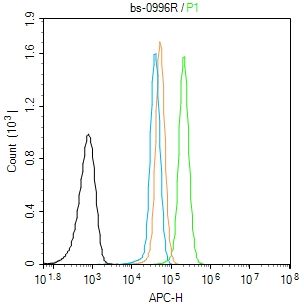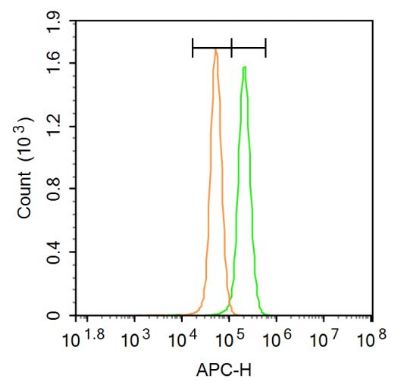产品中心
当前位置:首页>产品中心Anti-EphB2
货号: bs-0996R 基本售价: 380.0 元 规格: 20ul
- 规格:20ul
- 价格:380.00元
- 规格:50ul
- 价格:780.00元
- 规格:100ul
- 价格:1380.00元
- 规格:200ul
- 价格:2200.00元
产品信息
- 产品编号
- bs-0996R
- 英文名称
- EphB2
- 中文名称
- 酪氨酸蛋白激酶受体B2抗体
- 别 名
- Tyrosine-protein kinase receptor EPH-3; Developmentally regulated EPH related tyrosine kinase; ELK related protein tyrosine kinase; EPH tyrosine kinase 3; Ephrin type B receptor 2; Receptor protein-tyrosine kinase HEK5; Tyrosine protein kinase receptor QEK 5; Tyrosine-protein kinase TYRO5; Renal carcinoma antigen NY-REN-47; EPHB2; EPH receptor B2; EPHT3; HEK5; TYRO5; Cek5; Drt; Nuk; ETECK; Qek5; Sek3; ERK; Tyro5; Prkm5; EK5; Eph receptor B2; EPH-like kinase 5; EPHB2; EPHB2_HUMAN; Ephrin type-B receptor 2; hEK5; Nuk; Prkm 5; Sek 3; Tyro 5; Tyrosine protein kinase receptor CEK 5; Tyrosine protein kinase receptor EPH 3; Tyrosine-protein kinase receptor EPH-3.

- Specific References (1) | bs-0996R has been referenced in 1 publications.[IF=11.47] Choi, Won Hoon, et al. "Open-gate mutants of the mammalian proteasome show enhanced ubiquitin-conjugate degradation." Nature Communications 7 (2016). WB ; Human.PubMed:26957043
- 规格价格
- 50ul/780元购买 100ul/1380元购买 200ul/2200元购买 大包装/询价
- 说 明 书
- 50ul 100ul 200ul
- 研究领域
- 肿瘤 细胞生物 免疫学 信号转导 转录调节因子 激酶和磷酸酶 细胞膜受体
- 抗体来源
- Rabbit
- 克隆类型
- Polyclonal
- 交叉反应
- Human, Mouse, Rat, Chicken, Dog, Cow,
- 产品应用
- WB=1:500-2000 ELISA=1:500-1000 IHC-P=1:400-800 IHC-F=1:400-800 Flow-Cyt=3ug/Test IF=1:100-500 (石蜡切片需做抗原修复)
not yet tested in other applications.
optimal dilutions/concentrations should be determined by the end user.
- 分 子 量
- 108kDa
- 细胞定位
- 细胞浆 细胞膜
- 性 状
- Lyophilized or Liquid
- 浓 度
- 1mg/ml
- 免 疫 原
- KLH conjugated synthetic peptide derived from human Eph receptor B2:551-650/1055
- 亚 型
- IgG
- 纯化方法
- affinity purified by Protein A
- 储 存 液
- 0.01M TBS(pH7.4) with 1% BSA, 0.03% Proclin300 and 50% Glycerol.
- 保存条件
- Store at -20 °C for one year. Avoid repeated freeze/thaw cycles. The lyophilized antibody is stable at room temperature for at least one month and for greater than a year when kept at -20°C. When reconstituted in sterile pH 7.4 0.01M PBS or diluent of antibody the antibody is stable for at least two weeks at 2-4 °C.
- PubMed
- PubMed
- 产品介绍
- background:
This gene encodes a member of the Eph receptor family of receptor tyrosine kinase transmembrane glycoproteins. These receptors are composed of an N-terminal glycosylated ligand-binding domain, a transmembrane region and an intracellular kinase domain. They bind ligands called ephrins and are involved in diverse cellular processes including motility, division, and differentiation. A distinguishing characteristic of Eph-ephrin signaling is that both receptors and ligands are competent to transduce a signaling cascade, resulting in bidirectional signaling. This protein belongs to a subgroup of the Eph receptors called EphB. Proteins of this subgroup are distinguished from other members of the family by sequence homology and preferential binding affinity for membrane-bound ephrin-B ligands. Allelic variants are associated with prostate and brain cancer susceptibility. Alternative splicing results in multiple transcript variants. [provided by RefSeq, May 2015]
Function:
Receptor for members of the ephrin-B family. Phosphorylates ARHGEF15, leading to its ubiquitination and degradation by the proteasome which promotes EFNB1-dependent synapse formation. Can function in aspects of retinal ganglion cell axon guidance to the optic disk even when lacking its tyrosine kinase domain. Acts as a tumor suppressor.
Subunit:
Heterotetramer upon binding of the ligand. The heterotetramer is composed of an ephrin dimer and a receptor dimer. Oligomerization is probably required to induce biological responses. Interacts (via PDZ-binding motif) with GRIP1 and PICK1 (via PDZ domain). Interacts with ARHGEF15; mediates ARHGEF15 phosphorylation, ubiquitination and degradation by the proteasome. Interacts with AQP1; involved in endolymph production in the inner ear.
Subcellular Location:
Cell membrane; Single-pass type I membrane protein. Cell projection, axon. Cell projection, dendrite.
Tissue Specificity:
Brain, heart, lung, kidney, placenta, pancreas, liver and skeletal muscle. Preferentially expressed in fetal brain.
DISEASE:
Defects in EPHB2 may be a cause of susceptibility to prostate cancer (PC) [MIM:176807]. It is a malignancy originating in tissues of the prostate. Most prostate cancers are adenocarcinomas that develop in the acini of the prostatic ducts. Other rare histopathologic types of prostate cancer that occur in approximately 5% of patients include small cell carcinoma, mucinous carcinoma, prostatic ductal carcinoma, transitional cell carcinoma, squamous cell carcinoma, basal cell carcinoma, adenoid cystic carcinoma (basaloid), signet-ring cell carcinoma and neuroendocrine carcinoma. Note=EPHB2 mutations have been found in a prostate cancer cell line derived from a brain metastasis.
Similarity:
Belongs to the protein kinase superfamily. Tyr protein kinase family. Ephrin receptor subfamily.
Contains 2 fibronectin type-III domains.
Contains 1 protein kinase domain.
Contains 1 SAM (sterile alpha motif) domain.
SWISS:
P29323
Gene ID:
2048
Database links:Entrez Gene: 2048Human
Entrez Gene: 13844Mouse
Omim: 600997Human
SwissProt: P29323Human
SwissProt: P54763Mouse
Unigene: 523329Human
Unigene: 250981Mouse
Important Note:
This product as supplied is intended for research use only, not for use in human, therapeutic or diagnostic applications.
- 产品图片
 Blank control (Black line): A431 (Black).
Blank control (Black line): A431 (Black).
Primary Antibody (green line): Rabbit Anti-EphB2 antibody (bs-0996R)
Dilution: 1μg /10^6 cells;
Isotype Control Antibody (orange line): Rabbit IgG .
Secondary Antibody (white blue line): Goat anti-rabbit IgG-AF647
Dilution: 1μg /test.
Protocol
The cells were fixed with 4% PFA (10min at room temperature)and then permeabilized with 20% PBST for 20 min at room temperature. The cells were then incubated in 5%BSA to block non-specific protein-protein interactions for 30 min at -20℃ .Cells stained with Primary Antibody for 30 min at room temperature. The secondary antibody used for 40 min at room temperature. Acquisition of 20,000 events was performed. Blank control: A431.
Blank control: A431.
Primary Antibody (green line): Rabbit Anti-EphB2 antibody (bs-0996R)
Dilution: 3μg /10^6 cells;
Isotype Control Antibody (orange line): Rabbit IgG .
Secondary Antibody: Goat anti-rabbit IgG-AF647
Dilution: 3μg /test.
Protocol
The cells were fixed with 4% PFA (10min at room temperature)and then permeabilized with 20% PBST for 20 min at room temperature. The cells were then incubated in 5%BSA to block non-specific protein-protein interactions for 30 min at room temperature .Cells stained with Primary Antibody for 30 min at room temperature. The secondary antibody used for 40 min at room temperature. Acquisition of 20,000 events was performed.

